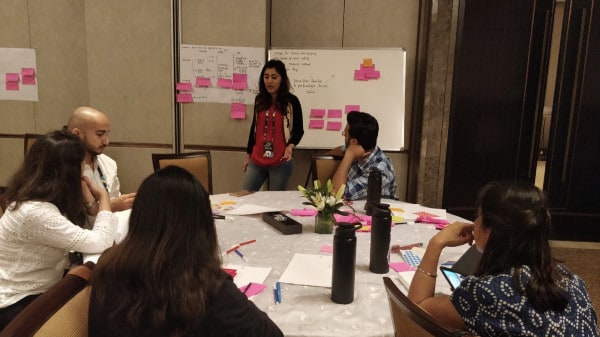A conversation with Neha Saigal, CEO & Founder of N5, an innovation and design strategy studio
Neha will be speaking at our upcoming event — Control the Room: The 1st Annual Austin Facilitator Summit! Taking place at Austin’s Capital Factory on May 23, 2019, learn more and get your tickets here.
Neha Saigal is a curious person by nature. As a child, her parents involved her in numerous extracurriculars — piano, public speaking, Russian ballet, tennis, Indian classical dance, and more. Her curiosity has driven her professional career starting with a degree in Finance and Economics followed by work as a Business Strategist and later as a creative in the advertising field.
“Eventually I started working on ad campaigns for ed tech products and wondered what it would be like to actually create products. I went back to school to study Interaction Design and have worked in product and innovation ever since.”

Looking back on her childhood, Neha’s grateful to her parents for exposing her to so many interests. She credits the experience for giving her the confidence to teach herself and an unwavering curiosity for trying new things. “This translates to my work, where I’m always experimenting with new methodologies and ways of working. That lack of fear of jumping in, experimenting, and trying things definitely comes from being thrown into a lot of uncomfortable situations as a kid.”
Innovation as experimentation
Curiosity and comfort with experimentation have given Neha a unique perspective on innovation. “Innovation is often considered to be disruptive and risky. This is diametrically opposed to a corporation’s view, which is typically risk-averse. But if you look at innovation as experimentation, you will find that it is the easiest and fastest way to reduce risk, bring clarity, and increase the probability of long-term success and value creation for an organization.”
“If you look at innovation as experimentation, you will find that it is the easiest and fastest way to reduce risk, bring clarity, and increase the probability of long term success…”
By approaching innovation more systematically through small experiments, Neha sees it as a risk mitigation strategy. “You don’t just have an idea and go build it, which a lot of people do. If you approach it with a mindset of experimenting in a simulated environment to see if something works, that goes hand-in-hand with being risk-averse.”

Neha sees innovation as a mindset. “It’s bringing the practice of experimentation to every aspect of business and adopting that mindset as organizations look at delivering new value to their customers.”
Infusing the experimental mindset into a team’s approach starts at the outset by acknowledging that nothing is known. “Experimentation and innovation are about figuring out what questions you need to ask. What assumptions need to be true for a business to work whether those are assumptions around the value proposition, costs, your revenue model, or how you deliver that value to your customers. It’s treating all of those facets of the business as questions that need to be answered.”

Once questions have been defined, Neha advises finding a way to prioritize them and systematically experimenting to answer them. PillPack is one company Neha notes that has embraced an assumptive approach. By setting up a pop-up shop in a mall, the PillPack team challenged assumptions about how people prefer to receive their medication. This experiment helped them learn that potential customers were interested in receiving medication delivered to their home, an approach that was adopted into their business model.
Key components for an innovation program, according to Neha, include:
- Teams that are physically separated from the core business
- Allowing and inviting room for failure
- Adopting an experimentation mindset for everything including other aspects of the business like cost structure
- Working in cross-functional squads
- Giving autonomy to teams to drive initiatives & supporting them with coaching from leadership and guidance from corporate strategy
- No end — only continuous experimentation
Physical separation for innovation teams is important to Neha because of the politics that come into play as company size increases. “Creating that sense of urgency, working under constraint, that sense of autonomous teams going out and experimenting becomes really hard when you’re trying to do it within the organization because the organization is set in its ways. It’s almost like gravity starts to take hold after a while.”

Neha uses the analogy of a cruise ship to further illustrate the case for physical separation: the innovation program is like a tug boat that needs to build momentum to change the direction of the ship, something it cannot do from aboard the ship. The separation allows innovation teams to function more closely to a startup working within constraints that allow creative thinking to flourish which can later be brought back into the company at large.
Neha shared that innovation doesn’t have to only be about disruptive products as it is often thought today. “If you look back in time at companies that were able to establish stronger footholds in their industry, a lot of it was getting creative with the strategies around the business model.”
To achieve this, Neha suggests expanding the idea of a cross-functional team to include people from Finance and Marketing so innovation can move beyond a feature focus to include the business model. “Rather than only focusing on the desirability component, imagine if you could structure truly cross-functional teams that are focusing on ensuring that in any venture, the viable, desirability and feasibility components are working in harmony.”
In addition to coaching, organizational leadership can support autonomous teams by providing a corporate strategy. “Having a clear strategy for how you’re going to play in the market can be so useful and powerful in leading teams in the right direction.” Too many frameworks and too much jargon can cause confusion, but a clearly-defined challenge gives teams something on which to focus their creative thinking.
“Cost leadership is not a strategy. Best consumer experience is not a strategy.”

“In the book, Good Strategy, Bad Strategy, the author Richard Rumelt talks about how most strategy that’s out in the world is absolute garbage because a strategy is really about framing a challenge. Cost leadership is not a strategy. Best consumer experience is not a strategy. A strategy is always an answer to a challenge, figuring out what is the overarching problem that we’re trying to solve, and how we’re going to go about solving that.”
Innovation is continuous
For Neha, innovation is a continuous process of identifying questions and assumptions and experimenting to learn as much as possible. Practices like design sprints, stand-ups, meetings, brainstorming sessions, though well-intentioned, are only useful if they live beyond a single event. “One of the problems is the one-and-done approach. The moment you approach it as this one special thing and forget about constantly testing your assumptions and experimenting, it’s not going to give you the desired results.”


Her advice for teams engaging in activities like design sprints is straightforward: continue. After uncovering the questions and assumptions that need to be addressed, take the experimentation beyond the design sprint or brainstorming session and continue to get clarity. She urges teams to also consider addressing multiple facets of the same question.
“Let’s say you come out of a design sprint and you have validated a direction. You’ve answered a couple of questions about desirability, which is mostly what you’ll end up answering questions about. How do you mitigate risk even further? How do you get more confidence in that direction?”
Continued experimentation allows for gradual risk mitigation. Neha learned this lesson from a failed product enhancement project of her own. After receiving customer requests for a new offering, her team took the feedback and created an MVP product, did one round of testing, and then went into four months of development. The product that was shipped ultimately didn’t solve for the right use cases and 6 months later wasn’t being used by customers.
“I think the biggest thing that I learned is that one round of testing is definitely not enough! You need to really ensure that people are going to want what you’re building and you’re solving for the right problem. Just having an idea of the problem is not enough. You need to make sure the details are worked out and ensure that you’re testing the revenue model.” That last point on testing the revenue model speaks to a more holistic approach to innovation that Neha believes is a critical factor for success.
“Helping teams I work with see every aspect of the business as something that needs to be designed excites me a lot.”
On her current project, Neha’s team is considering the question of subscription models as a way to insert recurring revenue into what might be a one time purchase as well as reconsidering costs. “You can do experimentation with costs by figuring out what costs the business needs to have that will actually lead to differentiation. Which costs are we assuming that we may need to infer, which we may not? Which costs are most closely and intrinsically linked to the value of the service?”

Measuring the outcomes of innovation
Experimentation is also where Neha looks for opportunities to measure the outcomes of innovation. “Innovation, by itself, cannot be measured. Rather an organization can measure the impact of innovation by looking at how experiments have reduced their risk for any initiative.” Seeking to measure innovation itself is not the right goal, according to Neha. “It might create the wrong motivation because you don’t want to innovate just to innovate.”

Instead, measure to what extent your experiments reduce the organization’s risk of failure. Neha recommends that teams create an experiment board to track experiments that have been run, questions that are still open, and tests that are being run to mitigate the risks. As teams learn, they track how much their confidence level increases with each experiment.
Neha admires companies that innovate by competing with their rivals on constraints rather than strengths. Neha’s favorite example of this is Southwest Airlines. The traditional airline business is difficult to break into and the market is saturated with big names offering perks like in-flight meals, airport lounges, first class, business class, etc.

What Neha loves about Southwest is that they purposely reduced a lot of the complexity. They standardized on the 737 to reduce cost on maintenance. They moved away from the main hub to secondary airports to offer more economical flights. They combined the flexibility of car transport with the speed of air travel and opened up the market to even more people. Southwest also focused on great customer service, which was unique among existing airlines.
“Innovation is often about knowing what not to focus on and looking at what’s missing in the market.”
Airbnb is another company that Neha sees as an example of going against the grain of a traditional market, in this case, hospitality, and competing on constraints. Airbnb looks at what’s missing in the existing market and constantly probes to see where they can create more value. Airbnb Trips is one addition that allows people to do local tours and adventures as well as visiting nearby cities, an adjacent market to the traditional vacation.
“I think Airbnb is doing a pretty good job. All of their teams are organized on outcomes. So you have a team that gets together to drive a particular outcome. It’s a startup within a startup, which I really like.”
If you want to read my other articles about innovation experts and practitioners, please check them all out here.




